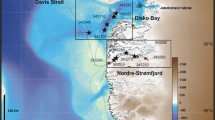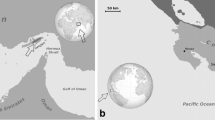Abstract
The purpose of the present paper is to study the morphological structure and variability of Azpeitia africana and to determine its geographical distribution in the surface sediments of the South China Sea (SCS). Sediment samples were collected with grabs or box corers in one cruise in 2001 and two cruises in 2007. The sampling stations were located between 3°56.61′–20°59.37′N and 108°30.68′–116°46.70′E, where the water depth ranged from 72 m to 4 238 m. The diatom was observed by phase contrast microscopy and scanning electron microscopy. Microscopical observation showed that A. africana had circular valves with the areolar lines radiating from the eccentric ring. The central rimoportula had an external tube recessed on the edge of a central ring. The marginal rimoportulae were not evenly spaced, and they were positioned more closely together in one quadrant than in the others. Azpeitia africana is the most abundant diatom species in the southern region of the SCS, and accounted for 0.9%–5.6% of all diatom species in the Xisha Islands area. Average cell density of A. africana was 1.1×105 valves/g. The percentage abundance of A. africana was low (0%–2.5%) in the northern regions of the SCS and the Sunda Shelf, and it was not detected in the northwestern continental shelf (shallow water area) and northern Kalimantan Island shelf. Our results suggested that A. africana is a typical warm water species and that it could be used as an indicator of the warm Pacific Ocean water, including the Kuroshio Current, flowing into the SCS.
Similar content being viewed by others
References
Abrantes F, Lopes C, Mix A, Pisias N. 2007. Diatoms in southeast pacific surface sediments reflect environmental properties. Quaternary Science Reviews, 26 (1-2): 155–169.
Baldauf J G, Barron J A. 1982. Diatom biostratigraphy and paleoecology of the type section of the Luisian Stage, central California. Micropaleontology, 28 (1): 59–84.
Barron J A, Bukry D, Cheshire H. 2014. Response of diatom and silicoflagellate assemblages in the central Gulf of California to regional climate change during the past 55 kyrs. Marine Micropaleontology, 108: 28–40.
Barron J A, Bukry D. 2007. Solar forcing of Gulf of California climate during the past 2000 yr suggested by diatoms and silicoflagellates. Marine Micropaleontology, 62 (2): 115–139.
Barron J A. 1980. Upper pliocene and quaternary diatom biostratigraphy of deep sea drilling project leg 54, tropical eastern Pacific. In: Rosendahl B R, Hekinian R eds. Initial Reports of the Deep Sea Drilling Project. U.S. Government Printing Office, Washington, DC. 54: 455–485.
Burckle L H. 1978. Early Miocene to Pliocene diatom datum levels for the equatorial Pacific. In: Proceedings of the Second Working Group meeting, Biostratigraphic Datum-Planes of the Pacific Neogene, IGCP Project 114. Badung, Indonesia. Republic of Indonesia Ministry of Mines and Energy, Directorate General of Mine, Geological Research and Development Center Spec. Pub., Badung, Indonesia. 1: 25–44.
Chakraborty A, Ghosh A K. 2016. Ocean upwelling and intense monsoonal activity based on late Miocene diatom assemblages from Neil Island, Andaman and Nicobar Islands, India. Marine Micropaleontology, 127: 26–41.
Fryxell G A, Sims P A, Watkins T P. 1986. Azpeitia (Bacillariophyceae): related genera and promorphology. S ystematic Botany Monographs, 13: 1–74.
Garcia M, Odebrecht C. 2012. Remarks on the morphology and distribution of some rare centric diatoms in southern Brazilian continental shelf and slope waters. Brazilian Journal of Oceanography, 60 (4): 415–427.
Guiry M D, Guiry G M. 2018. AlgaeBase. World-wide electronic publication, National University of Ireland, Galway. https://doi.org/www.algaebase.org. Accessed on 13 June 2018.
Guo Y J, Qian S B. 2003. Flora Algarum Marinarum Sinicarum Tomas V Bacillariphyta No.1 Centricae. Science Press, Beijing, China. 493p.
Håkansson H. 1984. The recent diatom succession of Lake Havgårdssjön, south Sweden. In: Mann D G ed. Proceedings of the Seventh International Diatom Symposium. Otto-Koeltz Science Publisher, Koenigstein. p.411–429.
Huang C Y, Liu S C, Cheng Z D, Mao Y H. 1998. Atlas of Lacustrine Fossils Diatom in China. China Ocean Press, Beijing, China. 164p. (in Chinese)
Hustedt F. 1927–1930. Die kieselalgen deutschlands, österreichs und der schweiz. In: Rabenhorsts Kryptogamen-Flora. Akad. Verlags, Leipzig. 7: 1–920.
Jiang H, Björck S, Ran L H, Huang Y, Li J Y. 2006. Impact of the Kuroshio Current on the South China Sea based on a 115000 year diatom record. Journal of Quaternary Science, 21 (4): 377–385.
Jiang H, Zheng Y L, Ran L H, Seidenkrantz M S. 2004. Diatoms from the surface sediments of the South China Sea and their relationships to modern hydrography. Marine Micropaleontology, 53 (3-4): 279–292.
Jiang H. 1987. Diatoms in offshore surface sediments in China. Acta Oceanologica Sinica, 9 (6): 735–743. (in Chinese with English abstract)
Jin D X, Chen J H, Huang K G. 1965. Marine Planktonic Diatoms of China. Shanghai Scientific & Technical Publishers, Shanghai, China. 230p. (in Chinese)
Jin D X, Cheng Z D, Lin J M, Liu S C, Tian C Z. 1980. Diatoms from the surface sediments of the East China Sea. Acta Oceanologica Sinica, 2 (1): 97–110. (in Chinese with English abstract)
Jin D X, Cheng Z D, Lin J M, Liu S C. 1982. The Marine Benthic Diatoms in China, Vol. 1. China Ocean Press, Beijing, China. 323p. (in Chinese)
Jousé A P, Kozlova O G, Muhina V V. 1971. Distribution of diatoms in the surface layer of sediment from the Pacific Ocean. In: Riedel W R, Funnell B M eds. The Micropaleontology of the Oceans. Cambridge University Press, Cambridge. p.263–269.
Jousé A P, Mukhina V V, Kozlova O G. 1969. Diatoms and silicoflagellates in the surface layer of sediments from the Pacific Ocean. In: Bezrukov P L ed. The Pacific Ocean. Vol. 7: Microflora and Microfauna in the Modern Sediments in the Pacific Ocean. Nauka Publishers, Moscow. p.7–47. (in Russian)
Lan D Z, Cheng Z D, Liu S C. 1995. Diatom in Late Quaternary Sediments from the South China Sea. China Ocean Press, Beijing, China. 138p. (in Chinese)
Liu R Y. 2008. Checklist of Marine Biota of China Seas. Science Press, Beijing, China. 600p. (in Chinese)
Ran L H, Jiang H. 2005. Distributions of the surface sediment diatoms from the South China Sea and their palaeoceanographic significance. Acta Micropalaeontologica Sinica, 22 (1): 97–106. (in Chinese with English abstract)
Ren J, Gersonde R, Esper O, Sancetta C. 2014. Diatom distributions in northern North Pacific surface sediments and their relationship to modern environmental variables. Palaeogeography, Palaeoclimatology, Palaeoecology, 402: 81–103.
Schmidt A. 1874–1959. Atlas der Diatomaceenkunde. Leipzig: R. Reisland, Ascherle ben.
Schrader H J. 1974. Cenozoic marine planktonic diatom stratigraphy of the tropical Indian Ocean. In: Fisher R L, Bunce E T eds. Initial Reports. Deep Sea Drilling Project, Vol. 24. U.S. Government Printing Office, Washington. p.887–967.
Seeberg-Elverfeldt I A, Lange C B, Pätzold J. 2004. Preservation of siliceous microplankton in surface sediments of the northern Red Sea. Marine Micropaleontology, 51 (3-4): 193–211.
Shiono M, Koizumi I. 2002. Taxonomy of the Azpeitia nodulifera group in Late Neogene sediments from the Northwest Pacific Ocean. Diatom Research, 17 (2): 337–361.
Simonsen R. 1974. The diatom plankton of the Indian Ocean expedition of R/V “Meteor” 1964–1965. ‘Meteor’ Forschungsergebnisse, Reihe D -Biologie, 19: 1–107.
Tempère J, Peragallo H M. 1915. Diatomées du Monde Entier. 2nd edn. Collection Tempère et Peragallo, Andrée-Lucie à Arcachon (Gironde), J. Tempère.
Wang R J, Abelmann A. 2002. Radiolarian responses to paleoceanographic events of the southern South China Sea during the Pleistocene. Marine Micropaleontology, 46 (1-2): 25–44.
Wu R, Gao Y H, Fang Q, Chen C P, Lan B B, Sun L, Lan D Z, 2013. Diatom assemblages in surface sediments from the South China Sea as environmental indicators. Chinese Journal of Oceanology and Limnology, 31 (1): 31–45.
Wytki K. 1961. Physical Oceanography of the Southeast Asia Waters. Naga Report, 2: 1–195.
Acknowledgments
We thank Elaine Monaghan BSc(Econ), from Liwen Bianji, Edanz Editing China (www.liwenbianji. cn/ac), for editing the English text of a draft of this manuscript.
Author information
Authors and Affiliations
Corresponding author
Additional information
Supported by the National Key Research and Development Program of China (No. 2016YFA0601302)
Rights and permissions
About this article
Cite this article
Wu, R., Gao, Y., Chen, C. et al. Morphology and distribution of the marine diatom Azpeitia africana (Janisch ex A. Schmidt) G. Fryxell & T. P. Watkins in the South China Sea. J. Ocean. Limnol. 37, 102–111 (2019). https://doi.org/10.1007/s00343-019-7248-4
Received:
Accepted:
Published:
Issue Date:
DOI: https://doi.org/10.1007/s00343-019-7248-4




